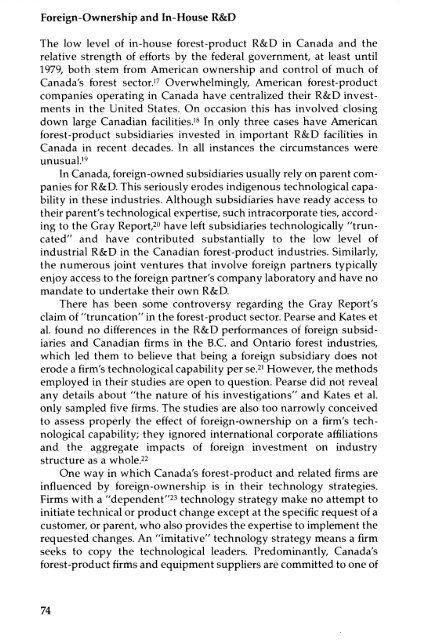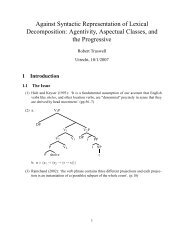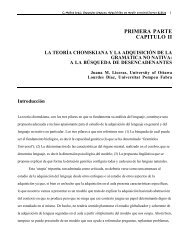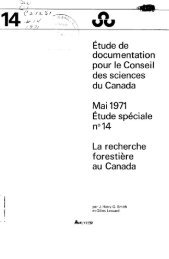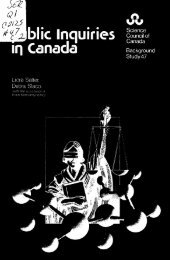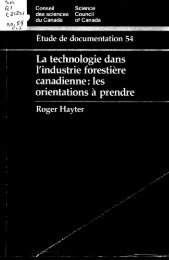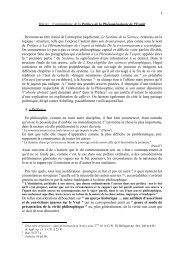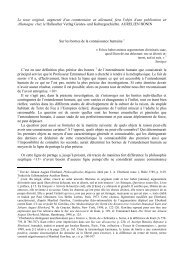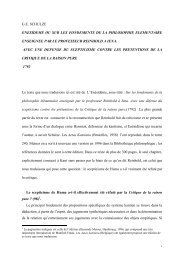Technology and the Canadian Forest-Product Industries ... - ArtSites
Technology and the Canadian Forest-Product Industries ... - ArtSites
Technology and the Canadian Forest-Product Industries ... - ArtSites
You also want an ePaper? Increase the reach of your titles
YUMPU automatically turns print PDFs into web optimized ePapers that Google loves.
Foreign-Ownership <strong>and</strong> In-House R&DThe low level of in-house forest-product R&D in Canada <strong>and</strong> <strong>the</strong>relative strength of efforts by <strong>the</strong> federal government, at least until1979, both stem from American ownership <strong>and</strong> control of much ofCanada's forest sector.'? Overwhelmingly, American forest-productcompanies operating in Canada have centralized <strong>the</strong>ir R&D investmentsin <strong>the</strong> United States. On occasion this has involved closingdown large <strong>Canadian</strong> facilities," In only three cases have Americanforest-product subsidiaries invested in important R&D facilities inCanada in recent decades. In all instances <strong>the</strong> circumstances wereunusual.'?In Canada, foreign-owned subsidiaries usually rely on parent companiesfor R&D. This seriously erodes indigenous technological capabilityin <strong>the</strong>se industries. Although subsidiaries have ready access to<strong>the</strong>ir parent's technological expertise, such intracorporate ties, accordingto <strong>the</strong> Gray Report." have left subsidiaries technologically "truncated"<strong>and</strong> have contributed substantially to <strong>the</strong> low level ofindustrial R&D in <strong>the</strong> <strong>Canadian</strong> forest-product industries. Similarly,<strong>the</strong> numerous joint ventures that involve foreign partners typicallyenjoy access to <strong>the</strong> foreign partner's company laboratory <strong>and</strong> have nom<strong>and</strong>ate to undertake <strong>the</strong>ir own R& D.There has been some controversy regarding <strong>the</strong> Gray Report'sclaim of "truncation" in <strong>the</strong> forest-product sector. Pearse <strong>and</strong> Kates etal. found no differences in <strong>the</strong> R&D performances of foreign subsidiaries<strong>and</strong> <strong>Canadian</strong> firms in <strong>the</strong> B.C. <strong>and</strong> Ontario forest industries,which led <strong>the</strong>m to believe that being a foreign subsidiary does noterode a firm's technological capability per se." However, <strong>the</strong> methodsemployed in <strong>the</strong>ir studies are open to question. Pearse did not revealany details about "<strong>the</strong> nature of his investigations" <strong>and</strong> Kates et al.only sampled five firms. The studies are also too narrowly conceivedto assess properly <strong>the</strong> effect of foreign-ownership on a firm's technologicalcapability; <strong>the</strong>y ignored international corporate affiliations<strong>and</strong> <strong>the</strong> aggregate impacts of foreign investment on industrystructure as a whole.FOne way in which Canada's forest-product <strong>and</strong> related firms areinfluenced by foreign-ownership is in <strong>the</strong>ir technology strategies.Firms with a "dependent"23 technology strategy make no attempt toinitiate technical or product change except at <strong>the</strong> specific request of acustomer, or parent, who also provides <strong>the</strong> expertise to implement <strong>the</strong>requested changes. An "imitative" technology strategy means a firmseeks to copy <strong>the</strong> technological leaders. Predominantly, Canada'sforest-product firms <strong>and</strong> equipment suppliers are committed to one of74


